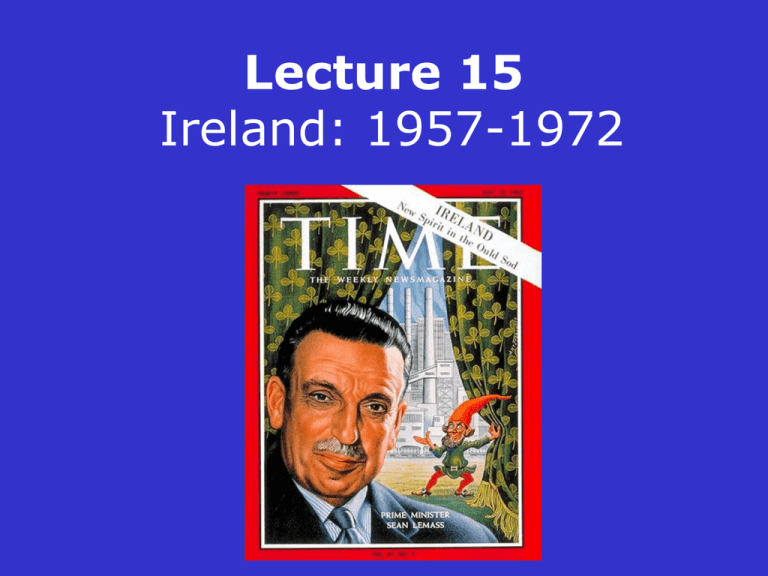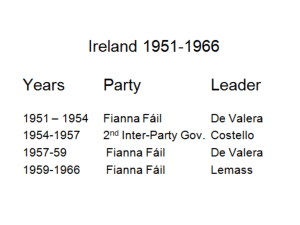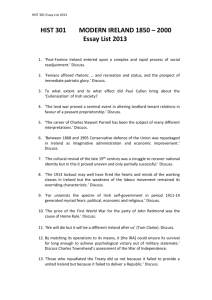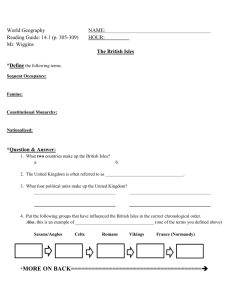Lecture 15 Ireland: 1957-1972
advertisement

Lecture 15 Ireland: 1957-1972 • FF returned to power in 1957 with 77 seats in a Dáil of 147 members • De Valera finally resigned in 1959 • Sean Lemass became party leader and Taoiseach. • Lemass introduced new and younger blood into the party leadership. Ireland in the 1950s • Ireland had been left behind economically and socially • The country had become increasingly poor and irrelevant Lemass and economic change • ‘Ironically…the protectionist apparatus of the 1930s was in large part the brainchild of Sean Lemass, who was Minister for Industry and Commerce for most of the years between 1932 and 1959.’ • Lemass ‘was the instigator of not one, but two historic reversals of economic policy, one in 1932 and the other in 1959.’ Garvin, T., Preventing the Future, p7. Why was Ireland so poor for so long? • The Catholic Church – blocked economic change • Mindset of the generation of the national revolution • Clientelist system ‘It is no coincidence that Ireland’s economic upturn occurred half a generation after the general Western economic lift-off in 1960 rather than in 1946; the upturn in Ireland coincided with, and was permitted by, the fading away of the generation of the national revolution.’ Garvin, Preventing the Future, p33. Economic planning • May 1958: T.K. Whitaker’s Economic Development delivered to government • Nov 1958: a White Paper derived from it was published under the title Programme for Economic Expansion. Programme for Economic Expansion • Regarded as a blueprint for modernization • Projected a 2 per cent annual increased in GNP over the following 5 years. • Highlighted the need for a change in direction away from protectionist policies. • Called for a five-year investment programme. • Recognised the importance of foreign investment and export led growth. The volume of GNP in 1958 was 2.5% below the level of 1955 and only 6.5% above the level in 1951. From 1960 to 1967 the economy expanded at a rate of 4% per annum Consequences of economic change • The average annual emigration rate (per 1000 of the population) stood at about 14 between 1951 and 1961. • It dropped to less than 5 between 1961 and 1971. • 44,427 emigrated in 1961 • Only 12,226 emigrated in 1963. • By 1966 the population had risen by 66,000. Consequences of economic change • The standard of living rose • Progress was made in terms of welfare provision for the underprivileged • The educational system underwent far-reaching change – secondary education is open to all in 1966 • Censorship was relaxed • Irish television service launched in 1961 Irish family on holiday in the 1960s In 1960 female workers received 53% of the male rate, which was to rise only to 54% in 1969 and 59% in 1971. A married woman was still regarded as the chattel of her husband There was still a marriage bar for women in the Civil Service Irish women workers earned only 55% of men's wages Many widows after a lifetime in the home ended their days in degrading poverty IWLM manifesto Published in early 1917 Attention was needed to the plight of unwed mothers, deserted wives, and those with broken marriages. IWLM tactics Radical confrontation Expressive and spontaneous action Consciousness raising Demonstrations Effective use of media, including newspaper, radio and television Charles Haughey (centre) with his solicitor and a friend Woman crossing O’Connell Street, Dublin, 1969






